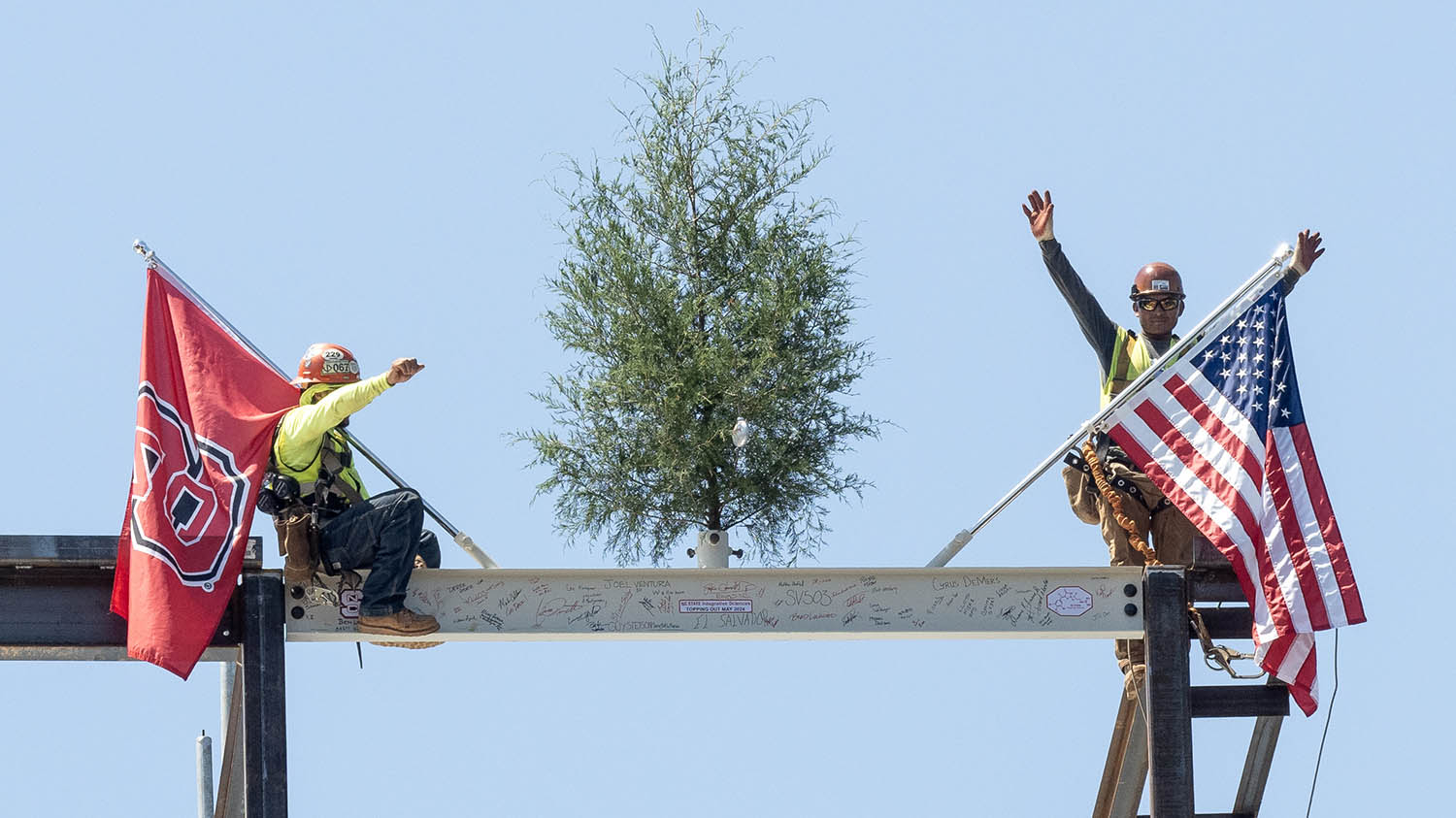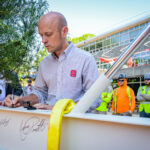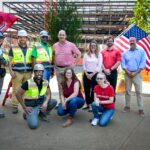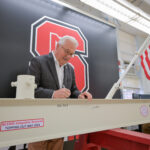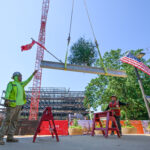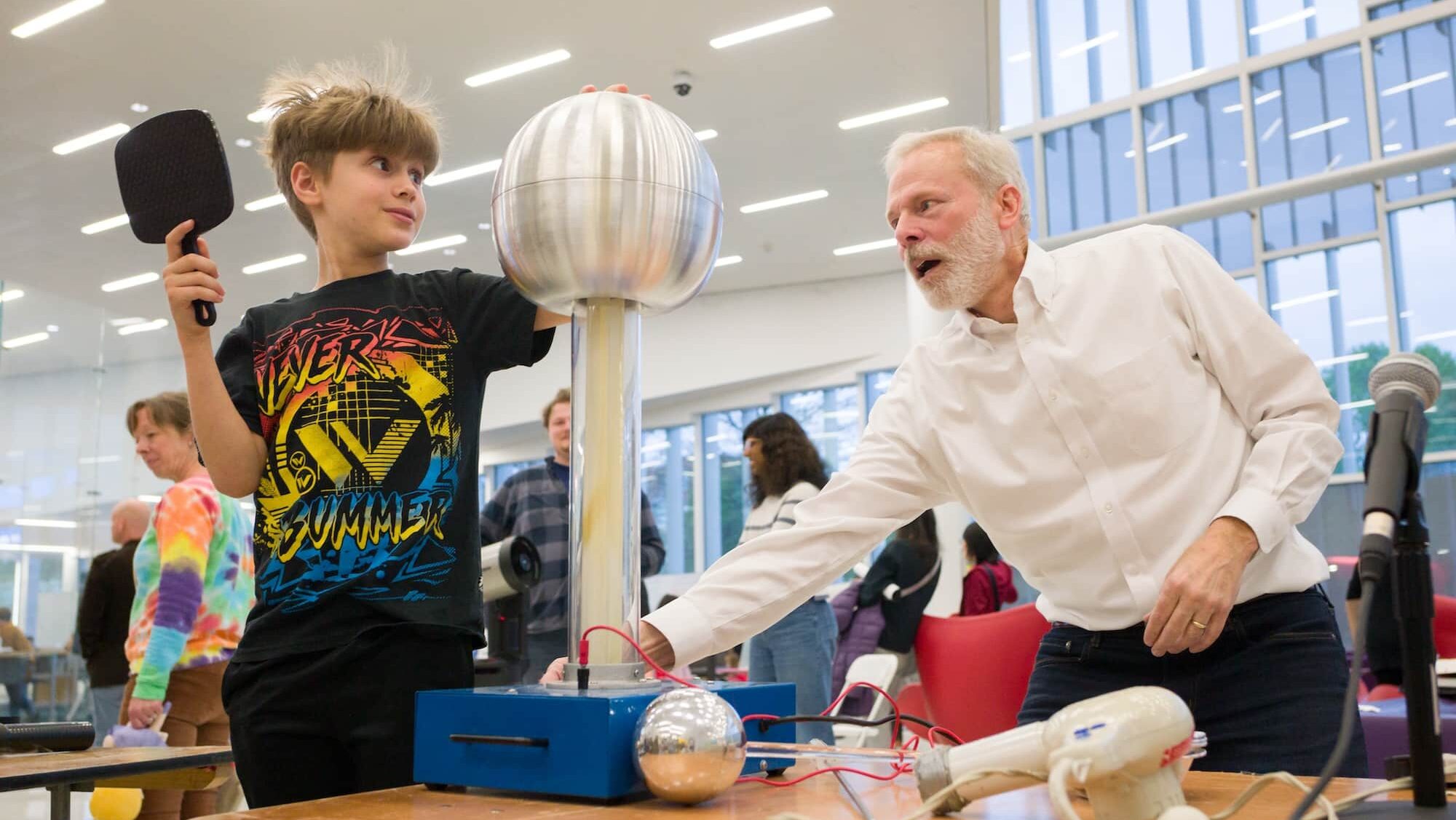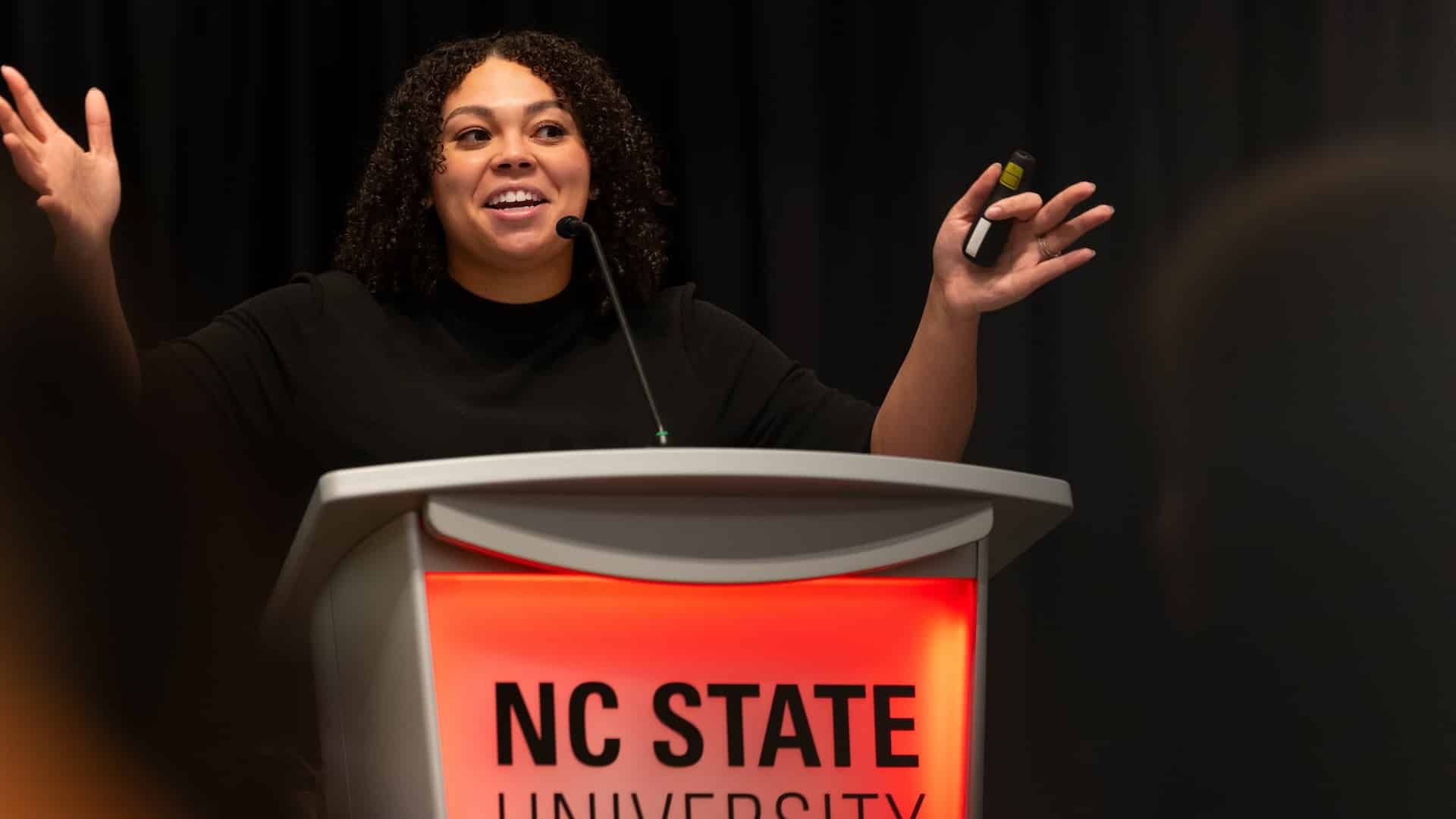A crowd of onlookers cheered the placing of the steel beam completing the bones of NC State’s Integrative Sciences Building during a topping out ceremony on May 22.
“Topping out” — a tradition dating back to 700 A.D. — marks the completion of the structural frame of a new building, during which the uppermost steel beam is set in place. An evergreen tree is often placed on top of the beam, representing good luck for the duration of the project. At this ceremony, the tree, flanked by American and NC State flags, rose to its new home atop the ISB with help from a large crane and Kenny Loggins’ “Danger Zone” playing in the background.
Raising the Final Beam
The beam was signed by employees of NC State, architect of record Moseley Architects and design architect ZGF, construction manager Skanska and structural engineers Lynch Mykins, as well as Chancellor Randy Woodson, representing the collaborative effort of many architects, engineers, construction workers and more to bring the building to its current state.
“Topping out ceremonies celebrate all the hard work that was put into the bones of the building. It represents a major milestone and turning point in the project,” said Mark Balling, executive vice president and general manager of Skanska. “In the future, walls can be moved around, paint colors can change, but the bones will always be there. There is a particularly interesting and very large truss that holds up a portion of the roof and the floor — that was certainly worth celebrating.”
The crowd gathered under the shadow of the building to hear from Balling and Joshua Pierce, executive director of the Integrative Sciences Initiative, part of the Office of University Interdisciplinary Programs.
“As we place this final beam, we are reminded that the growth and prosperity of this building is not just for NC State, but for the entire state of North Carolina as a hub for scientific discovery,” Pierce said.
Stimulating Scientific Discovery
Polk, Cox and Dabney Halls, NC State’s main STEM buildings to date, were all constructed more than 50 years ago. The demand for STEM courses — more than half of NC State graduates major in STEM fields, with each graduate taking at least two or more chemistry courses — has necessitated additional space by way of a new, state-of-the-art facility.
Upon completion of construction (scheduled for 2026), the ISB will unite a dynamic community of interdisciplinary scholars committed to developing molecular solutions that address society’s most pressing human, animal and plant health challenges. The $180 million ($90 million of which is provided by the state), 153,000 square foot structure will allow for the connection of existing STEM centers on campus, and enliven the Brickyard by making the area a hive of scientific innovation and education.
“NC State produces one-third of UNC System graduates with a STEM degree,” said Rob Dunn, senior vice provost for University Interdisciplinary Programs. “With more students entering the university each academic year and with ever-greater demand for STEM graduates in the public and private sectors, there has never been a better time to invest in interdisciplinary scholarship and research.”
The building will include teaching and student research spaces and cutting-edge core labs, turbocharging NC State’s ability to create and visualize new kinds of molecules and put them to use in novel technologies. Of course, each part of the structure will be built with interdisciplinary science in mind.
“I got to sit in on early design meetings for the Integrative Sciences Building where they made decisions on the building’s overall concept, program, and massing scheme,” said Moseley Architects intern Shane Fogarty, a 2024 graduate with bachelor’s degrees in environmental design and environmental sciences. “It’s exciting to think about how this building will shape campus for future students. I think the building design and landscaping will bring more students to an area of campus that is historically the center of student activities. I’m jealous of the future students that get to walk through that space on their way to class each day!”
ISB Facts and Figures
- 153,000 Square Feet
- The building will include a mix of teaching, research, collaboration, amenity and support space
- 134,000+ Cubic Feet of concrete
- Includes foundations, walls, slab-on-grade, concrete on metal deck
- 1,000+ tons of steel
- Structural steel skeleton frame
Proven Partnerships
Each beam of the ISB, including the final one placed during the topping out ceremony, represents the strength of a longstanding partnership between NC State and Skanska.
“We have a strong relationship because of trust and great teams. The university’s culture and values align with ours, and that makes the relationship that much stronger,” said Balling. “NC State can always depend on us to deliver a world-class project every single time.”
Skanska has completed more than one million square feet of building projects for NC State in the past 30 years. This includes Fitts-Woolard Hall, the Hunt Library, Engineering Building III, the Engineering Graduate Research Center, the Biomanufacturing Training and Education Center and the Partners Way Parking Deck.
Always Part of the Pack
Wherever you go in Raleigh or around the world, you’re sure to run into a member of the Wolfpack family. That’s the case with those connected to the ISB, including Lynch Mykins CEO Anna Lynch (‘09 Master of Engineering) and VHB Engineering’s Katie Haney (‘20 Bachelor of Science in Civil Engineering), who spoke about their experience at NC State and their involvement in the project.
Anna Lynch

How did you come to your position at Lynch Mykins?
In 2003 I moved to Raleigh from Wyoming to start as a structural engineer at Stroud Pence (which later became Lynch Mykins). Over my 21 years here I’ve worked hard to progress from design engineer to project engineer, to project manager, to principal, to managing director, to CEO! I have held almost every position in the firm, so I understand our business inside and out. I would say I got to the CEO role because of my grit and perseverance.
What is your role in the development of the Integrative Sciences Building?
Lynch Mykins was the structural engineer of record on the Integrative Sciences Building. Our designs ensure this building will stand up for years to come!
What has your experience been like working on a project housed at your alma mater?
We love working with NC State and this project was no different. Many of our Lynch Mykins staff attended NC State, so it makes us proud to bring beautiful buildings and growth to such a wonderfully supportive university! Honestly, the staff fights over NC State projects — isn’t it always your dream to work on projects at your alma mater?
What makes the Integrative Sciences Building unique, and what are you most proud of with this project?
Not only is ISB an amazingly beautiful building, but it’s right in the Brickyard! As an engineer and an NC State alum, it’s exciting to think that ISB could be one of the first buildings a prospective NC State student will see and help shape their experience of the campus. If I’d seen it as a young engineer, I would definitely have chosen NC State!
Katie Haney

How did you come to your position at VHB?
Post college, I immediately started my career at a company that was mainly focused on residential. I wanted to expand my experience and gain knowledge related to different types of projects. Transitioning to VHB has provided me with several opportunities to work on a team of resilient, efficient engineers and designers with projects that include residential, institutional and commercial.
What is your role in the development of the Integrative Sciences Building?
I have been able to help with the design of stormwater and sewer on-site. I was also able to perform a handful of site inspections during construction of the Integrative Sciences Building.
What has your experience been like working on a project housed at your alma mater?
I have thoroughly enjoyed being part of a great team working on the Integrative Sciences Building. All of my classes were located in Mann Hall, so to see something new and unique come to main campus is exciting for how this will shape our current and future NC State community.
What makes the Integrative Sciences Building unique, and what are you most proud of with this project?
The Integrative Sciences Building is unique with increasing the relationship between research and teaching within all five floors. The Integrative Sciences First Year Program will be the beginning of NC State’s goal with transforming the educational and research environment for students. Throughout college, you learn fundamentals and skills with how to succeed in the real world. I am most proud to utilize knowledge I have gained throughout my classes from professors at NC State with the design of the utilities on site.
What’s Next
Construction of the ISB continues to gain momentum after the topping out ceremony, with the next major milestone, the enclosure of the building, scheduled for May 2025. After completion, the building is expected to achieve Leadership in Energy and Environmental Design Silver status in 2026. This means that the initial steps have been taken to reduce the building’s environmental impact and make its operation more sustainable.
Completion of the ISB will be made possible with $90 million in funding from the North Carolina State Legislature, and $90 million from NC State, encompassing the generous contributions of private donors. This includes a recent $125,000 founding commitment from Skanska, which will name Laboratory Rooms 169/171.
“We are incredibly grateful to the legislature and the donors who believe in our mission to transform the sciences at NC State,” said Pierce.
“The Integrative Sciences Building will allow researchers to foster innovation and discoveries in a way that NC State hasn’t been able to do before and we’re excited to be constructing the space to make it happen,” said Balling. “We’re always proud to innovate with NC State!”
This post was originally published in Provost's Office News.
- Categories:
